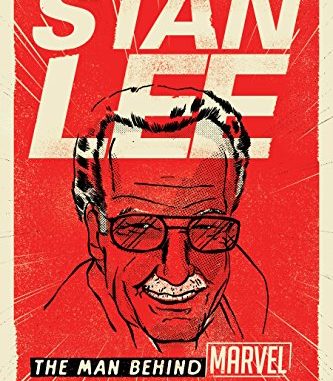
 Review Fix chats with author Bob Batchelor who discusses his book, “Stan Lee: The Man Behind Marvel.†Detailing the creative process behind the work and his life-long fascination with Lee and Comic Books, Batchelor lets us know why it’s a special project for him.
Review Fix chats with author Bob Batchelor who discusses his book, “Stan Lee: The Man Behind Marvel.†Detailing the creative process behind the work and his life-long fascination with Lee and Comic Books, Batchelor lets us know why it’s a special project for him.
About the Author:
Batchelor (www.bobbatchelor.com) teaches in the Media, Journalism & Film Department at Miami University in Oxford, Ohio, is the author or editor of more than 25 books, including Mad Men: A Cultural History, John Updike: A Critical Biography, and Gatsby: The Cultural History of the Great American Novel, among others. He is a noted popular culture commentator.
For more on the book, Click Here,
Review Fix: What inspired this book?
Bob Batchelor: There were two major inspirations for Stan Lee: The Man Behind Marvel. First, my lifelong interest in Marvel comic books and, second, my inclination that many self-professed Marvel and Stan Lee really do not know that much about the comic book legend. They love him in the film cameos and love the characters, but do not know much about the real person.
When I interviewed Lee and Marvel fans prior to writing the book, I saw that the majority had little knowledge of his amazing life. I realized that my best bet would be to write a biography deeply steeped in archival research that provided an objective portrait that would give readers insight and analysis into his life and career. The research provided a deeply nuanced view of Lee’s life that I then convey to the reader. This commitment to the research and uncovering the man behind the myth is the driving force in the book.
My personal interest in Lee dates back to my childhood in the early 1970s. I had a relative who gave me a big stack of old comics as a kid and I was so eager to really dig in that the combination of The Electric Company and Marvel comics got me reading and created a lifelong interest in both reading and writing.
Review Fix: What comics did you read as a kid? How did they affect you?
Batchelor: As a youngster growing up in Western Pennsylvania, my family did not have much money for buying new comic books. However, back then, it seemed as if everyone had comics in the attic or a stack tucked away somewhere that they were willing to share or give away. I always tracked more toward Marvel, but I really read everything I could get my hands on. This experience – enjoying Batman and the Justice League nearly as much as The Avengers and Spider-Man – left me without those strong feelings toward one publisher or the other that so many fans hold. I will add, though, that Marvel grew more important as I got older.
The most important comic book for me personally was the vastly underrated What If? series. What If? #3 completely changed my life, because it featured a new interpretation of Marvel history in which Iron Man saves the Avengers, but is killed in the process by Sub-Mariner and Hulk. That comic book demonstrated that history could be told from various viewpoints and perspectives. It transformed the way I saw history and storytelling and set me on the course toward becoming a writer and cultural historian. And to think, I was only eight years old at the time!
Review Fix: Why does Stan Lee still matter?
Batchelor: The superheroes that Lee and his co-creators brought to life in Marvel comic books are at the heart of contemporary storytelling. Lee created a narrative foundation that has fueled pop culture for nearly six decades. While countless shelves have been filled with books about comic book history and those responsible for originating this uniquely American form of mass communication, there are still many reasons to examine Lee’s specific role.
History and context are important in helping people comprehend their worlds. New comic book readers and ardent filmgoers who turn out in droves to see Marvel Universe films should grasp how these influences impact their worldviews. By establishing the voice of Marvel superheroes and shepherding the comic books to life as the head of Marvel, Lee cemented his place in American history. I truly believe that Lee is one of the most important creative icons of his lifetime!
Review Fix: How would you describe your writing style to someone who’s never read you?
Batchelor: Regardless of the topic, storytelling is my foundation. Trying to figure out what makes a fictional character like Don Draper or Jay Gatsby tick versus an actual person like Lee or Bob Dylan, I am putting the storytelling pieces together to drive toward a better understanding. Phillip Sipiora, one of my mentors who teaches at the University of South Florida, is famous for saying that there aren’t really definitive answers, rather than the goal of the critic should be interrogation and analysis. I am not searching for the right answer, rather hoping to add to the body of knowledge by looking at a topic in a new or innovative way.
Throughout the process, I reserve time to just think deeply about the subject. I find that meditative time is essential. The fact that most people can no longer stand quiet, reflective time is one of the great tragedies to emerge from the web. I create basic outlines to guide my writing and thinking and constantly edit and revise. When I coach writers, I urge them to find a process that works for them, and then to hone it over time. My process fuels my work and enables me to work efficiently.
By engaging with subjects deeply through research and analysis, I find that I am able to tell the story in a really engaging manner. I focus on powerful writing that is fueled by strong research so that a larger portrait emerges that provides cultural and historical context.
Review Fix: What makes this book unique? Stan Lee has been written about a lot.
Batchelor: Given that Lee is a mythic figure to many Marvel and comic book fans, I think what I have done well in the biography is present a full portrait of Lee as a publishing professional, film and television executive, cultural icon, and family man. One gets the sense of Lee as all these things when examining his archive at the American Heritage Center at the University of Wyoming. Lee is so much more than the much-anticipated film cameos and the biography attempts to reveal his family background, sorrows, triumphs, and successes in a way that hasn’t been done before.
The uniqueness of Stan Lee is that it provides a full-scale biography of the Marvel icon with his story at the center of the narrative. Of course, there is a great deal of history and culture in telling Lee’s story, but he drives it forward. And, I think this is important, because people read biographies to explore life from another person’s perspective and to imagine the world in which that person lived. Stan Lee tells Lee’s tale in new and interesting ways and gives readers a full picture of contemporary America in the process.
Review Fix: Who do you think will enjoy it the most?
Batchelor: From the feedback I have already received, it seems that readers interested in comic book history are really enjoying the book. That seems the most natural audience. But, a person does not have to know much about Lee to like it. Several people who grew up with comic books, but did not know a great deal about Lee, told me that they loved reading about his work and finding out about his life in greater detail than what one might find on the web or in a brief write-up.
Review Fix: Bottom line, why must someone read it?
Batchelor: Lee’s legacy is undeniable: he transformed storytelling by introducing generations of readers to flawed heroes who also dealt with life’s everyday challenges, in addition to the treats that could destroy humankind.
Generations of artists, writers, actors, and other creative types have been inspired, moved, or encouraged by the Marvel Universe he gave voice to and birthed. Lee did not invent the imperfect hero, one could argue that such heroes had been around since Homer’s time and even before, but Lee did deliver it – Johnny Appleseed style, a dime or so a pop – to a generation of readers hungry for something new.
The Fantastic Four transformed the kinds of stories comic books could tell. Spider-Man, however, brought the idea home to a global audience. Lee told an interviewer that he had two incredibly instinctive objectives: introduce a superhero “terribly realistic†and one “with whom the reader could relate.â€
While the nerd-to-hero storyline seems like it must have sprung from the earth fully formed, Lee gave readers a new way of looking at what it meant to be a hero and spun the notion of who might be heroic in a way that spoke to the rapidly expanding number of comic book buyers. Spider-Man’s popularity revealed the attraction to the idea of a tainted hero, but at the same time, the character hit the newsstands at the perfect time, ranging from the growing Baby Boomer generation to the optimism of John F. Kennedy’s Camelot, this confluence of events resulting in a new age for comic books. Stan Lee tells the whole story of Lee’s life, which also helps us understand our own culture and times.
Review Fix: What’s next?
Batchelor: I have several writing projects underway, but I am also expanding my work to include more multimedia work, including film and radio. There is still so much more that is left to be uncovered about American culture. My goal is to continue bringing big, important subjects to light in new and interesting ways.
Review Fix: Anything else you’d like to add?
Batchelor: In looking at a person’s life, especially one as long as Lee’s (he’ll turn 95 at the end of the year), context and historical analysis provide the depth necessary to create a compelling picture. For example, Lee grew up during the Great Depression and his family struggled mightily, barely staying above the poverty line thanks to financial help from family members and more than a little luck. I saw strains of this experience at play throughout Lee’s life that I then emphasized and discussed in the biography.
As a cultural historian, my career is built around analyzing context and nuance, so that drive to uncover a person’s life within their times is at the heart of the narrative. Then I hope to show how one person’s life can help us all make sense of our own lives and times in which we live. Stan Lee’s life story illustrates the best attributes of the American Dream.


Leave a Reply